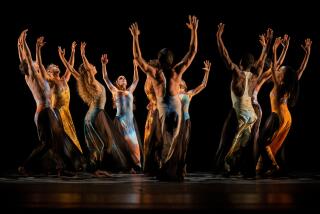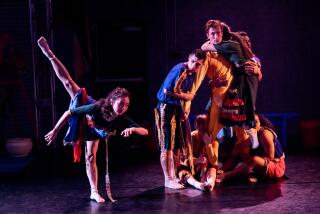TECHNIQUE AS A LETHAL WEAPON : ALVIN AILEY COMPANY AT WILTERN
Spectacularly fit, explosively energetic but hard as nails, the 29-member Alvin Ailey dance company opened a six-day engagement at the Wiltern Theatre on Tuesday with a mixed program that offered three dramatic displays of what might be called Rambo-dancing: technique used like a lethal weapon.
Accurately reflecting the defensive mood of the late ‘80s, Ailey’s “Witness,” “Caverna Magica” and, in particular, Ulysses Dove’s “Bad Blood” (all a year old) capitalize on ferocious intensity and a punchy movement style--ideas embodied as physical combat.
At the same time, each work exudes cold ‘80s glamour through lush production values: everything from fancy scenery to outlandish, drop-dead haircuts.
Twenty-seven years ago, in the “I Want to Be Ready” solo from “Revelations,” Ailey simply, feelingly expressed a man’s faith in God and joy in serving Him. No sweat, no frills. More soulful spirituals accompany “Witness,” but this solo finds company powerhouse Marilyn Banks lashing herself into an apocalyptic frenzy in front of 100 votive candles. Lots of sweat, lots of frills.
Violently whirling, reaching, shuddering and sprawling, Banks hurls herself through space as if on some cosmic search-and-destroy mission, and she will not be denied: God had better accept her. Or else.
Equally intimidating, the volcanic, forceful April Berry rules heaven and earth in “Caverna Magica,” stalking the stage in her billowing rainbow-cape and summoning everything from processions of cowering followers to thunder and lightning. Even Carol Vollet Garner’s gauzy, grotto-esque scenery-layers rise and descend at her fierce command.
Unfortunately, “Caverna Magica” falls apart whenever Berry leaves the stage. The music by Andreas Vollenweider has inspired Ailey to explore dynamic relationships and cross-cultural influences that his current company simply cannot bring off--not Banks and Daniel Clark in their prominent solos and duets, not the ensemble members in the exotic, ceremonial dancing. They’re sluggers, and this challenge is more like kung fu.
In “Bad Blood,” what they can do becomes overwhelming, what they can’t inconsequential. Dove (a former Ailey dancer) has made a piece about contemporary sex warfare that taxes the company’s athleticism and daring to the utmost, filling his punishing bouts with bravura gymnastics but keeping his subject sharply in focus.
Male rage and female desperation are the primary engines driving the work, with music by Laurie Anderson providing both accompaniment and biting commentary.
After a relatively conventional solo by Carl Bailey, the pairs square off--Renee Robinson and Stephen Smith, Marey Griffith and Andre Tyson, Debora Chase and Max Luna--the women throwing themselves high into the air, the men sometimes catching them (often on their necks and shoulders), elsewhere contemptuously flinging them away.
Clenched fists and flying bodies: That’s the height of Ailey dancing in 1987, and it’s pretty sensational. The low? Movement requiring sustained energy flow or a smooth articulation of any conventional technique. Here the company looks painfully subprofessional--and never more so than in Ailey’s classic “Night Creature,” which, in 1975, showcased the company’s peerless versatility and sophistication.
To symphonic jazz by Duke Ellington, Ailey had deftly fused jazz, modern and social dancing along with lots of ballet fireworks. Indeed, this conglomerate idiom became his most celebrated achievement as a choreographer, and it is shocking to watch his current company fail miserably at it: smearing the steps, faking the style, overplaying the jokes.
Happily, stellar company alumna Donna Wood dropped by Tuesday for “Pas de ‘Duke’ ” and offered an object lesson in effortless, elegant, accomplished Ailey/Ellington dancing. And she wasn’t alone.
In this quasi-competitive 1976 star vehicle (created for Judith Jamison and Mikhail Baryshnikov), Wood danced opposite Patrick Dupond, a visiting virtuoso from the Paris Opera Ballet.
In his Los Angeles debut, Dupond unleashed turns to die for, enforced aristocratic placement even in the unlikeliest of choreographic contexts, and revealed an endearing tendency to overproject everything--especially the sly gestural graffiti that Wood and other seasoned Ailey dancers so expertly throw away.
More to Read
The biggest entertainment stories
Get our big stories about Hollywood, film, television, music, arts, culture and more right in your inbox as soon as they publish.
You may occasionally receive promotional content from the Los Angeles Times.










